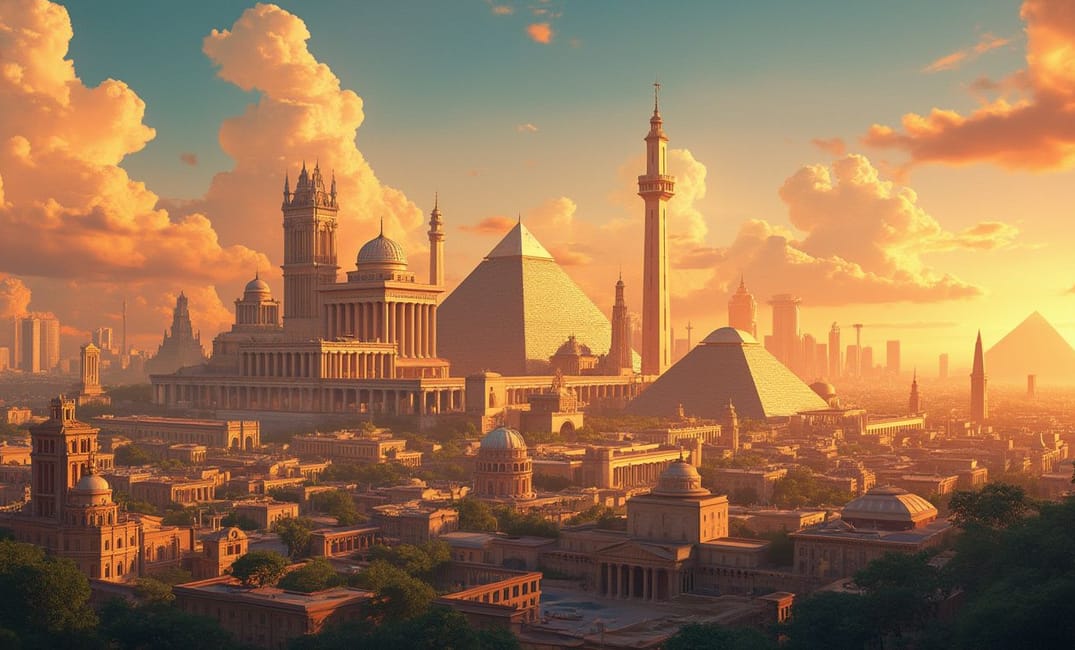Introduction: Building the Story of Humanity
Human civilization is a story not only of people and events but also of the structures they build. Architecture, at its core, is a reflection of human ingenuity, a testament to technological progression, and the embodiment of cultural ethos. From the pyramids of Egypt to the modern skyscrapers piercing the clouds, architecture shapes and molds the very fabric of human society. This entry explores humanity's architectural achievements, uncovering the spiritual, functional, and artistic elements that have driven the development of the spaces people inhabit.
Ancient Architectures: The Foundations of Human Innovation
Monumental Beginnings: Stone and Earth
- Neolithic Structures and Stonehenge: The earliest known architectural endeavors date back to the Neolithic era, with constructs like Stonehenge. These structures, often aligned with celestial bodies, reveal human attempts to link earthly domains with the cosmos. They served as communal spaces for ritual and gathering, embodying the nascent understanding of space and community.
- Ziggurats and Architectural Cosmology: The ziggurats of Mesopotamia exemplify early monumental architecture designed to elevate the sacred. These terraced mounds reflect both religious devotion and societal hierarchy, signaling a society's complex relationship with their spiritual beliefs and environment.
Mastery of Monumental Engineering
- The Egyptian Pyramids: Geometry of Eternity: The pyramids of Egypt, especially the Great Pyramid of Giza, are enduring symbols of a civilization's architectural zeal. Constructed using precise mathematical and astronomical knowledge, these monuments showcased both practical engineering prowess and spiritual grandeur, serving as eternal resting places for pharaohs.
- The Indus Valley Civilization's Urban Planning: The meticulous urban planning seen in cities like Mohenjo-Daro and Harappa reveal an advanced understanding of spatial arrangement, sanitation, and civic organization. They embody the principles of early urbanism, introducing concepts like grid layouts and sophisticated drainage systems for improving communal living.
Classical Antiquity: Harmony, Order, and Aesthetics
The Classical World: Temples of Democracy and Thought
- Greek Temples and the Parthenon: Greek architecture epitomized aesthetic refinement, marrying form and function. The Parthenon in Athens, dedicated to the goddess Athena, exemplifies the Doric order's elegance, symmetry, and mathematical precision, marking an enduring pursuit of architectural beauty and philosophical expression.
- Roman Engineering and the Colosseum: Roman architecture, characterized by its grand scale and engineering ingenuity, manifested society's ambition and unity. The Colosseum stands as an icon of Roman technological advancement and public life, using arches, vaults, and concrete to accommodate thousands for spectacles and social gathering.
The Power of Construction: Roads and Aqueducts
- Infrastructure and Roman Roads: The Roman Empire's vast network of roads exemplified their commitment to connectivity and governance. These roads facilitated trade, military expeditions, and cultural exchange, laying the foundation for modern transportation infrastructure.
- Aqueducts: Engineering Marvels: Aqueducts, like the Pont du Gard in France, epitomize Roman hydraulic engineering. These structures were critical in supplying water to cities, demonstrating the intersection of civil necessity and technical mastery, crucial for the urban sustainment of growing populations.
The Middle Ages: Spiritual Spaces and Feudalism
The Triumph of Verticality: Gothic Architecture
- The Rise of Cathedrals: Gothic architecture embodied the spiritual aspiration of the Middle Ages. Cathedrals like Notre-Dame and Chartres reached toward the heavens with their pointed arches, ribbed vaults, and flying buttresses. These structures were not merely places of worship but community centers and representations of divine beauty.
- Stained Glass and Narratives in Light: The intricate stained glass windows of Gothic cathedrals served as means to convey biblical tales and saintly histories, transforming light into visual storytelling mediums that inspired awe and devotion within sacred halls.
Feudal Fortresses: Castles and Defense
- Castles: Bastions of Medieval Power: Castles, with their imposing stone walls and strategic locations, were symbols of feudal authority and protection. Structures like the Tower of London represented the feudal system's military and societal structures, functioning as residences, fortresses, and administrative centers.
- Technological Advances in Fortification: Advances in castle architecture, such as concentric walls and moats, reflect evolving military technologies and strategies. These innovations in defensive architecture influenced the power dynamics and territorial control of medieval Europe.
The Renaissance and Beyond: Enlightenment in Stone and Space
Renaissance Reawakening: Rebirth of Classical Ideals
- Revival through Symmetry and Proportion: Renaissance architecture marked the resurgence of Classical Greek and Roman aesthetics, emphasizing balance, symmetry, and perspective. Architects like Brunelleschi pioneered the use of linear perspective, transforming architectural blueprints with mathematical precision and harmonious design.
- Florence's Architectural Marvels: Structures such as the Florence Cathedral and its iconic dome showcase the blend of Gothic forms with burgeoning Renaissance ideals. Brunelleschi's dome became an architectural masterpiece, symbolizing both a spiritual and artistic reawakening in an era defined by innovation.
Baroque Grandeur and Transcendence
- Dramatic and Opulent Baroque: The Baroque period witnessed an explosion of grandeur and opulence in architecture, characterized by elaborate ornamentation and dynamic forms. Buildings like the Palace of Versailles reflected powerful aesthetics, inciting emotional engagement through their lavish designs and spatial fluidity.
- Theatrical Space as Expression: Baroque architects played with light, shadow, and space to create dramatic and immersive environments. These elements transformed religious and civic architecture from mere structures into compelling narratives in stone, expressing authority and divine splendor.
Modern Architecture: Functionality, Ambition, and Identity
The Age of Revolution: Industrial and Social Shifts
- Iron and Glass: Revolutionizing Material Use: The Industrial Revolution heralded new materials and methods, exemplified by structures such as the Crystal Palace. The combination of iron and glass allowed for unprecedented scale and transparency, fostering new public spaces like exhibition halls.
- Urban Expansion and Skyscrapers: Innovations in steel-frame construction and elevators led to the rise of skyscrapers, reshaping cityscapes in an emblem of modern ambition and economic vitality. Buildings such as the Empire State Building symbolize the burgeoning aspirations of urban centers.
Towards Contemporary and Sustainable Design
- The Rise of Modernism: Form Follows Function: Architects like Le Corbusier and Frank Lloyd Wright advocated for designs that emphasized function and simplicity over ornamentation, resulting in streamlined forms and open spaces. Bauhaus and International Style movements celebrated minimalism and utility, reflecting modern perspectives on space and human interaction.
- Sustainability and Environmental Integration: Contemporary architecture increasingly focuses on sustainability and environmental integration. Innovations such as green roofs, solar panels, and sustainable materials illustrate an evolving awareness of environmental stewardship, directly influencing architectural principles and practices.
Conclusion: Humanity's Enduring Structures and Aspirations
Architecture remains a cornerstone of human civilization, symbolizing cultural ideals and aspirations through the ages. From ancient stone circles to futuristic cities, the built environment continues to echo humanity's technological progress, aesthetic sensibility, and communal values. As people look towards the stars with distant hope of new worlds, the structures once familiar may guide future endeavors, weaving continuity through our shared cosmic journey.
"Architecture is the silent orator of civilizations, carving in stone the resilience, dreams, and aspirations that define humanity's enduring journey through time and space."
MODERNISM, SUSTAINABILITY, GOTHIC, HISTORY, CIVILIZATION, ENGINEERING, MONUMENTS, ARCHITECTURE, RENAISSANCE

